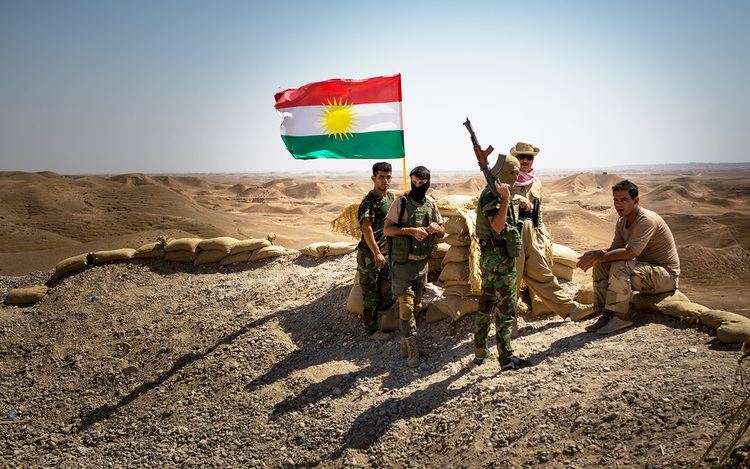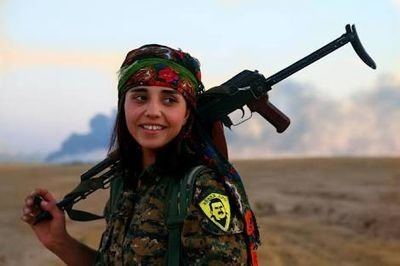Active Early 1920s–present Size 150,000–200,000 Founded 2003 | Branch Army | |
 | ||
Engagements First Iraqi–Kurdish WarSecond Iraqi–Kurdish WarIran–Iraq WarPersian Gulf WarIraq WarKurdish–Turkish conflict (1978–present)War on TerrorSyrian Civil WarIraqi insurgency (2011–2013)Iraqi Civil War (2014–present)Other battles and wars Minister of Peshmerga Affairs Mustafa Qadir Mustafa Aziz | ||
Peshmerga vs the islamic state the road to mosul full length
Peshmerga (Central Kurdish: پێشمەرگە, Pêşmerge, [peːʃmɛɾˈɡɛ]) are the military forces of the autonomous region of Iraqi Kurdistan. The overall formal head of the peshmerga is the President of Iraqi Kurdistan. The peshmerga force itself is largely divided and controlled separately by the Democratic Party of Kurdistan and the Patriotic Union of Kurdistan, although both pledge allegiance to the Kurdistan Regional Government. Efforts are under way to gather the entire force under the Ministry of Peshmerga Affairs. Peshmerga forces are responsible for defending the land, people and institutions of Iraqi Kurdistan.
Contents
- Peshmerga vs the islamic state the road to mosul full length
- Exclusive peshmerga soldiers in brutal firefight vs isis
- History
- Structure
- Equipment
- References

Because the Iraqi Army is forbidden by law from entering Iraqi Kurdistan, the peshmerga, along with other Kurdish security subsidiaries, are responsible for the security of the Kurdish Region. These subsidiaries include Asayish (official intelligence agency), Parastin u Zanyarî and (Dzha Terror) (assisting intelligence agency) and the Zeravani (military police).

In 2003, during the Iraq War, peshmerga were said to have played a key role in the mission to capture Saddam Hussein. In 2004, they captured key al Qaeda figure Hassan Ghul, who revealed the identity of Osama Bin Laden's messenger, which eventually led to Operation Neptune Spear and the death of Osama Bin Laden.

Following a large-scale Islamic State offensive against Iraqi Kurdistan in August 2014, peshmerga and Kurdish forces from neighboring countries have been waging war against the Islamic State of Iraq and the Levant in both Iraq and Syria.
Exclusive peshmerga soldiers in brutal firefight vs isis
History
The Kurdish warrior tradition of rebellion has existed for thousands of years along with aspirations for independence, and early Kurdish warriors fought against the various Persian empires, the Ottoman Empire and the British Empire. However, the term "peshmerga" was only coined in the mid-20th century, by the Kurdish writer Ibrahim Ahmad. Peshmerga means "one who confronts death" or "one who faces death". "Pesh" means to stand in front of (loosely translated as to confront or face) while "merga" means death.
Historically the peshmerga existed only as guerilla organizations, but under the self-declared Republic of Mahabad (1946–1947), the peshmerga led by Mustafa Barzani became the official army of the republic. After the fall of the republic and the execution of head of state Qazi Muhammad, peshmerga forces reemerged as guerilla organizations that would go on to fight the Iranian and Iraqi governments for the remainder of the century.
In Iraq, most of these peshmerga were led by Mustafa Barzani of the Kurdistan Democratic Party. In 1975 the peshmerga were defeated in the Second Iraqi-Kurdish War. Jalal Talabani, a leading member of the KDP, left the same year to revitalize the resistance and founded the Patriotic Union of Kurdistan. This event created the baseline for the political discontent between the KDP and PUK that to this day divides peshmerga forces and much of Kurdish society in Iraqi Kurdistan.
After Mustafa Barzani's death in 1979, his son Masoud Barzani took his position. As tension increased between KDP and PUK, most peshmerga fought to keep a region under their own party's control, while also fighting off Iraqi Army incursions. Following the First Persian Gulf War, Iraqi Kurdistan saw the Kurdish Civil War between the two major parties, the KDP and the PUK, and peshmerga forces were used to fight each other. The civil war officially ended in September 1998, when Barzani and Talabani signed the Washington Agreement establishing a formal peace treaty. In the agreement, the parties agreed to share revenue and power, deny the use of northern Iraq to the Kurdistan Workers' Party (PKK), and not allow Iraqi troops into the Kurdish regions. By then, around 5,000 had been killed on both sides, and many more had been evicted for being on the wrong side. In the years after, tension remained high, but both parties moved towards each other and in 2003 they both took part in the overthrowing of the Baathist regime as part of the Iraq War. They remained on good terms, forming a government of Iraqi Kurdistan. Unlike other militia forces, the peshmerga were never prohibited by Iraqi law.
In 2015, for the first time, peshmerga soldiers received urban warfare and military intelligence training from foreign trainers, the Combined Joint Task Force - Operation Inherent Resolve.
Structure
The exact size of peshmerga forces is unknown as there are different estimates ranging from as few as 80,000 all the way up to 250,000. These forces are organized into 36 military brigades, controlled separately with little to no inter-coordination, by the KDP, PUK and Ministry of Peshmerga Affairs.
The peshmerga force, like much of Iraqi Kurdistan, is plagued by frequent allegations of corruption, partisanship, nepotism, and fraud. These allegations include giving high-ranking military positions only to fellow clansmen and/or party members, fighting for political parties rather than the Kurdish people as a whole, and the use of "ghost soldiers" to gain peshmerga benefits and salary. Much of this is due to the fact that peshmerga forces are still unofficially divided along the main party lines, although with arguably less tension than during the Kurdish Civil War. Peshmerga with ties to the Kurdistan Democratic Party are responsible for the Dohuk Governorate and Erbil Governorate, while those with ties to the Patriotic Union of Kurdistan oversee the security in Sulaymaniyah Governorate. Following the June 2014 ISIS invasion of Iraq and the retreat of the Iraqi Army, the Kurdistan Regional Government (KRG) filled the void and took control of almost all disputed areas. These areas have since also been divided between KDP and PUK peshmerga.
As a result of the split nature of the peshmerga force, there is no central command center in charge of the entire force, and peshmerga units instead follow separate military hierarchies depending on political allegiance. Efforts have since been made to minimize partisanship, including the banning of partisan flags from the battlefield. A political reform is also currently underway to place the entire force under the single command of the regional government. As of January 2015, 12 out of the 36 brigades have reportedly been put under the control of the KRG, with the remaining 70% of peshmerga forces still controlled by the regions' two main parties.
Due to limited funding and the vast size of the peshmerga forces, the KRG has long planned to greatly downsize its forces from large numbers of low-quality forces to a smaller but much more effective and well-trained force. Consequently, in 2009, the KRG and Baghdad engaged in discussions about incorporating parts of the peshmerga forces into the Iraqi Army, in what would be the 15th and 16th Iraqi Army divisions. However, after increasing tension between Erbil and Baghdad regarding the disputed areas, the transfer was largely put on hold. Some peshmerga were already transferred but reportedly deserted again, and there are allegations that former peshmerga forces remain loyal to the KRG rather than their Iraqi chain of command.
While the majority of the peshmerga forces are Muslims, there are also Assyrian Christian and Yezidi units fighting under the direction of peshmerga forces, such as the Êzîdxan Protection Force.
Although almost entirely made up of men, peshmerga forces have been known to include small numbers of women since its formation, and currently have 600 women in their ranks. In the KDP, these female peshmerga have so far been refused access to the frontline and are mostly used in logistics and management positions, but female PUK peshmerga are deployed in the frontlines and are actively fighting ISIS.
As of January 2015, the peshmerga forces are still divided among three entities: the Ministry of Peshmerga Affairs, KDP, and PUK.
The units under command of the KDP politburo, unofficially called Yakray 80:
- Hezakanî Gulan (Gulan Forces), an elite force tasked with defending the president and the presidential compound.
- Hezakanî Barzan (Barzan Forces), another brigade formation, consisting of men recruited from the president's own clan.
- Ten additional brigades constitute a 20,000-strong force.
- Zeravani units, administratively supported by the Ministry of the Interior.
The units under command of the PUK politburo, unofficially called Yakray 70:
- Dizha Tiror (Counterterrorism Group) an elite anti-terror formation.
- Two presidential brigades, tasked with defending the Iraqi president.
- Hezekanî Kosrat Rasul, another brigade tasked with defending the vice president.
- 15 brigades consisting of men loyal to PUK.
Equipment
The peshmerga arsenal is limited and confined by restrictions because the Kurdish Region is not an independent state. Due to disputes between the KRG and the Iraqi government, arms flow from Baghdad to Iraqi Kurdistan has been almost nonexistent, as Baghdad fears Kurdish aspirations for independence. Peshmerga forces instead largely rely on old arms captured from the old Iraqi Army during the 2003 U.S. invasion of Iraq, in which peshmerga forces were active.
Before that, some weapons were also captured during the 1991 Iraqi uprisings. Following the retreat of the new Iraqi Army during the June 2014 ISIS offensive, peshmerga forces reportedly again managed to get hold of some weapons left behind by the Army. Since August 2014, peshmerga forces have also captured some weapons from ISIS.
After the ISIS offensive of August 2014, multiple governments decided to arm the peshmerga with some light equipment, such as light arms, night goggles and ammunition. However, Kurdish officials and peshmerga have stressed that they are not receiving enough. They also stress that Baghdad is blocking even small arms from reaching the KRG, emphasizing the need for weapons to be sent directly to the KRG and not through Baghdad.
